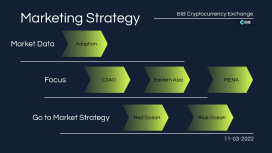GO-To-Market Strategy
Transcript: GO-To-Market Strategy Lean Go To market Maximize the value you provide to your customers while minimizing waste in your organization Growth Hacking Process of rapid experimentation across marketing channels and product development to identify the most effective, efficient ways to grow a business. Network Effect Network effect is the effect that one user of a good or service has on the value of that product to other people A traditional marketer has a very broad focus, and while their skill set is extremely valuable, it is not as necessary early in a startups life. In the first phase of a startup you don’t need someone to “build and manage a marketing team” or “manage outside vendors” or even “establish a strategic marketing plan to achieve corporate objectives” or many of the other things that marketers are tasked with doing. Early in a startup you need one thing. Growth. - Redefining Product: Minimum viable product - Redefining Distribution: Most bang for least buck Examples: AirBnB, Ship Your Enemies Glitter, PokeMon Go This is where you identify the primary channels that you’ll use—both to sell your products and to educate and support your customers—along with the resources, training, and incentives that will drive channel performance. In complex channel organizations, products and offers may differ from one channel to the next, playing on the unique advantages of specific channels, such as direct sales teams or online portals. Thank You! Positioning SMB Automation of the sales process Provision of needs Large Companies Need for a Sales Team Creating relationship Strong vertical sales and support for ecosystem Marketing strategy is usually focused on who to sell to and what to sell. The boundaries of marketing strategy run across functional lines inside an organization but marketing primarily interacts with two other functions in a company. First, marketing interacts with development via product marketing to convey market requirements and to provide content for communications and sales tools for selling. Marketing also interacts with sales to build pipeline and assist in closing opportunity more quickly. Go-to-Market Strategy is focused on how the organization will put offerings into the market to reach market penetration, revenue and profitability expectations. This charter is a super set of marketing strategy as it impacts all functions within an organization with the goal of preparing the entire company for market success. Another key point to stress is that G0-to-Market Strategy is not an event, i.e., a product launch. GTM strategy is focused on the entire product life cycle—from concept to grave. Why the approach works Customer path way Tech Channels of communication Breadth of the channel Advanced data analytics The go-to marketing arsenal Niche research for value Global and emerging markets Speed of change What you see on Runway is in Stores Flow of idea Lean Go to Market These requirements, which may be affected by decisions made in the previous sections of the plan, may include branding your customer-facing portals, and integrating sales and provisioning systems with third-party resources you’ve employed. Parallels can help you identify the technical requirements needed to launch your products. Growth Hacking Technical Requirements Customer Experience/Customer Journey Product Strategy Marketing Strategy/Value Proposition Come up with a Go to Market strategy for 1 of the following and assess the chances of success: - Tesla in Pakistan - Yelp in Pakistan - Autonomous Car in Pakistan This area summarizes the activities you’ll use to drive awareness and generate leads, both in your identified markets and within your existing customer base. In large organizations, the marketing strategy may also include activities for generating internal awareness. Marketing Strategy vs Go to Marketing Strategy Critical Mass - Supply Side and demand Side Localized strategy for geo-location and legal environment Execution speed and low touch transaction Solve a compelling business problem in a differentiated manner that demands a premium Determine the size of the market opportunity Decide upon the beach head target for initial market penetration strategy Identify the decision makers, approvers, recommenders, influencers and snipers Understand the business issues for decision makers and develop a unique selling proposition that resonates Establish a differentiated position from substitutes and alternatives Prepare a product roadmap and complete product life cycle plan Document the distribution strategy and corresponding sales process Create an integrated demand generation plan to create qualified opportunities Develop a comprehensive and methodical demand management plan to follow-up on qualified opportunities Prepare an implementation plan to ensure the offering is set-up to perform properly Train the support organization to handle implementation and end-user inquiries It is important to measure success. This step

















